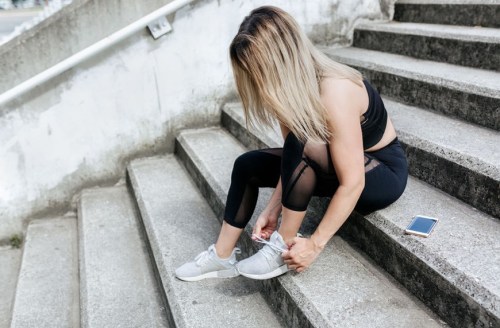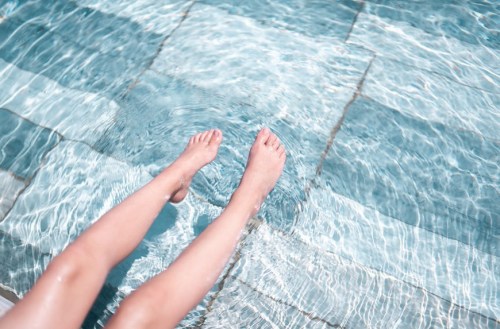Our editors independently select these products. Making a purchase through our links may earn Well+Good a commission
Few things are worse, IMO, than when someone asks you to remove your shoes upon entering their house. Whether your toes are deformed from a childhood spent in pointe shoes or your nails are just in need of a paint job there are, in my mind, few (if any) commonly-exposed body parts so cringe-worthy as those located south of your ankles.
All sorts of things can go wrong with your southernmost appendages, especially given their frequent use in a variety of circumstances. “I treat plantar fasciitis, or heel pain, various other aches and pains, sprains and strains, diseases of the skin and nails, bunions, hammertoes, and more,” says NYC-based podiatrist Dr. Ernest Isaacson. Below, he and Yolanda Ragland, DPM, podiatrist, foot surgeon, and owner of Fix Your Feet, share intel on some of the most common issues with which patients step into their practices, including remedies so you no longer have to run away when someone asks you to go sans shoes. (Or is that just me?)
Keep reading for everything you need to know in order to put your best foot forward.

Athlete’s foot
Nothing is sexier than a fungal infection, right? Athlete’s foot is just such a condition, a fungi invasion that may present as itchy, peeling skin, or moist skin between the toes. It is most common, says Dr. Isaacson, in the summer when feet sweat because the fungus likes warm, wet places.
Despite its moniker, this condition can happen to SoulCycle buffs and Netflix bingers alike. “One doesn’t have to be Lebron James to develop athlete’s foot,” says Dr. Isaacson. Certain people are, however, more at risk than others. “There are two types of people when it comes to contracting athlete’s foot,” explains Dr. Ragland. “People who are susceptible to developing the infection, and those who are not.” In other words, if you have been a sufferer of athlete’s Foot in the past, it’s likely the fungus will recur in the future.
For this reason, prevention is key. “Wearing clean, wick-absorbing socks, or footies, helps to discourage fungal growth, says Dr. Ragland. “Using anti-fungal creams, gels, sprays, or powders, daily, will also significantly reduce repeat-infection rate.” If, despite your best efforts, the fungus persists, you can also take prescription oral meditation. “[It should be limited] however, due to its effect on your liver,” Dr. Isaacson says.
Bunions
I don’t know about you, but I actually had no idea what a bunion was until I looked into it for this story. “A bunion is a bony prominence of the big toe joint,” Dr. Ragland explains. “The long bone connected to the base of the toe, called a ‘metatarsal’, is in poor alignment and protrudes outward, forming a bump, while the big toe rotates inwardly pushing up against the second toe.” Oh, so it’s not some sort of extra-bad callous or wart-looking thing? Apparently not. “Contrary to the perceived common knowledge, this is primarily a congenital condition, not necessarily caused by shoes or activity, although the latter can exacerbate and potentially accelerate development,” explains Dr. Isaacson.
If the condition is not painful, say both doctors, then no treatment is necessary. “If it is painful, initially we recommend the use of wider shoes, and orthotics can alleviate some pain by supporting the foot although they are not likely to prevent further progress,” Dr. Isaacson says. In his opinion, the splints and devices that are sold in pharmacies, catalogs, and online are not effective in preventing or treating a bunion—so save your cash, as you may need it. “If a bunion is painful enough to affect quality of life, surgery is a valid proven treatment option that works—with surprisingly less downtime and pain than may be commonly expected,” he says. Dr. Ragland also points out that the condition can “ruin” shoes, which is another reason to opt in on surgery. (I’ll say!)
Calluses
Calluses, while ugly and sometimes painful, are actually trying to do a good thing for your foot. “They’re formed as a protective armor for the skin, so it does not break down,” says Dr. Ragland. “Non-painful calluses on a healthy foot do not need any treatment; however, a thick callus can be painful to walk on, much like having a pebble stuck to the skin.”
If yours bugs you, Ragland says you can treat it by removing the top layer of thickened skin. One way in which this is done is likely familiar if you’re a fan of regular pedicures—using a pumice stone or an emery board, you can (slowly and gently) grind down the hardened skin. A second method, which uses a blade-type instrument (e.g. a razor) to cut or shave the affected skin, should only be attempted after consulting a podiatrist. A third utilizes an acid-based agent—generally a urea-based salve or salicylic acid treatment—to slough the tough skin down. This too, should only be tried in consult with your doctor. The final option, says Ragland, is complete excision. “The callus can be fully removed along with the normal, underlying skin and closed with stitches,” she says. “This procedure can be performed in the office by your podiatrist, but is reserved for extreme cases and is rarely recommended because the scar from the excision can be just as painful as the callus.”
In some populations, calluses can lead to more serious conditions than a temporary limp. “Patients that are immunocompromised, like diabetics, are at risk of ulceration in the areas where once the callus could form, but due to a weakened immune system can no longer do so,” says Dr. Ragland. “This skin becomes friable and ulcerates, now increasing risk for infection which could ultimately lead to amputations if not treated immediately.” For this reason, Dr. Isaacson tells me he recommends periodic routine foot care to both prevent and expose any occult wounds in these patients.

Smelly feet
Worry not if you’re one of those people who makes others faint when they remove their shoes. (Hi dad!) “Except in rare circumstances or severe infections, smelly feet are just a sign of smelly feet,” says Dr. Isaacson. “Start with the simple remedies—use a spray on antiperspirant to reduce sweating, sprinkle some anti-fungal foot powder in the shoes to absorb moisture, and use an over-the-counter charcoal insert to absorb the odor,” he says. Dr. Ragland also says that astringents, which cause contraction of the skin, can help to close pores and block sweat glands, thereby eliminating unpleasant scents. “Homeopathic, astringent-based remedies include Hydrofluoricum Acidum, Silicea, and Witch Hazel,” she says. (A foot bath can help, too.)
If this is a chronic issue for you, you may also want to investigate the cause of excessive sweating, advises Dr. Ragland, “Hyperhidrosis [excessive sweating] can be linked to anxiety, excessive coffee drinking, consumption of alcohol, neurological conditions, diseases like diabetes, hormone changes, hyperthyroidism, tumors, infections and even mercury poisoning,” she explains.
With those underlying issues cleared, you should consult your podiatrist about medical intervention if you’ve exhausted the conservative therapies listed above (along with the patience of your loved ones). “While these are more invasive or pharmaceutical, these are longer-lasting and have proven to be extremely effective,” she explains.
Yellow nails
If your toenails have turned this hue, says Dr. Isaacson, there could be an innocuous culprit. “Toenail polish can leave a residual discoloration that is only apparent after removing the polish,” he says. Another reason for yellowing nails is trauma to the nail. “Something minor such as rubbing on a tight shoe or repetitive stress from exercise [can lead to this condition],” Dr. Isaacson explains. Finally, he says, concerning colors could come from fungal growth.
Fungal nails
According to Dr. Isaacson, such growth generally begins as athlete’s foot which slowly creeps in to the nail; however, there also seems to be a hereditary connection. “Some people have more of a tendency to contract this infection, which is generally not just due to hygiene or exposure, and it tends to run in the family,” he says.
To remedy fungal nails, you need specific treatments designed to penetrate the nail plate and treat the nail bed. “This means regular athlete’s foot creams and most over-the-counter remedies are ineffective,” says Dr. Isaacson. “Effective treatments are oral medications that act systemically to eradicate the infection at its source, a limited number of prescription and over-the-counter topical medications that are designed to penetrate the nail, and laser treatments that also penetrate the nail and kill the fungus at its source.”

Blisters
Blisters, says Dr. Isaacson, are varied in origin. “The most common types are those due to friction from activity or rubbing,” he says (as every New Yorker alive nods emphatically.) “These can be avoided by ensuring shoes and socks fit properly, reducing friction with the use of topical gels or tape, and padding any areas that may rub against a shoe.” Blisters can also be caused by athlete’s foot or even swelling from a fracture. “Generally we recommend you avoid popping a blister as it creates an open wound where there was intact sterile skin,” the doctor advises. “If the blister seems to be in danger of popping or is very painful due to fluid buildup, then there recommended course of treatment is to drain the fluid, gently peel the skin away, and apply a bandage and antibiotic ointment.” Since there is risk of infection in this scenario, Dr. Isaacson recommends following up with a doctor.
Ingrown nails
“An ingrown toenail is a process in which the nail grows into the skin on the sides of the nail,” says Dr. Isaacson, who tells me podiatrists such as himself treat these regularly. “They can be caused by improper cutting of the nail, generally by trying to cut the corners and not quite getting to the leading edge of the nail, which then becomes a spike of nail digging into the skin.” In some cases, he adds, they can also be due to the curved anatomy of the nail that digs into the skin on the side of the toe.
If the condition is mild then it can be prevented, maintained, or treated at home by gently separating the skin from the nail; however, if the area is red or painful, or if there is any discharge or pus present, then the area should be evaluated by a podiatrist as soon as possible, says Dr. Isaacson. If your ingrown toenails are recurrent, your podiatrist can perform a quick and relatively painless procedure to remove the border of the nail permanently.
Detached toenail
“There is almost nothing more viscerally disturbing to most people than the idea of a detached toenail,” says Dr. Isaacson, reading my mind as I shudder at the thought. He advises those who experience toenail loss not to panic, however. “In most cases, the new nail will grow in just fine within six-to-nine months,” he says. “And because the skin under the nail forms a natural callus-like protective layer as the nail grows in, there is very little chance of infection or further trauma.”
Most often, toe nail loss results from injury, fungal infection, or psoriasis, says Dr. Ragland. “Psoriasis causes changes in the nails which may result in a dry brittle nail causing the nail to left from the nail bed and eventually fall from its attachment to the skin,” she explains. More rarely, chemicals, medications, and serious illness can be contributing factors as well. “Illnesses like cancer that require chemotherapy to attack fast-growing cells can result in toenail disfigurement or loss,” Dr. Ragland says.
If your feet ache, there’s a simple hack that can help. If they’re perpetually cold, however, you might want to seek pro help—it could be a symptom of something serious.
Sign Up for Our Daily Newsletter
Get all the latest in wellness, trends, food, fitness, beauty, and more delivered right to your inbox.
Got it, you've been added to our email list.











